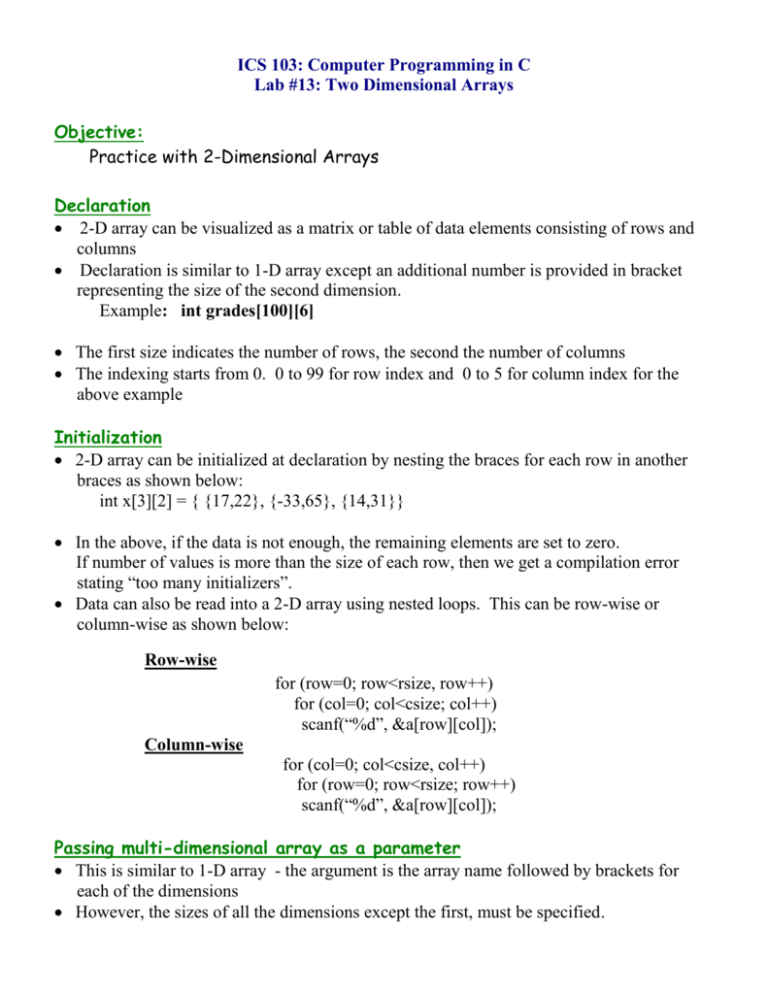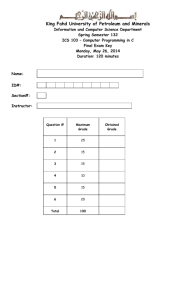2-D Arrays
advertisement

ICS 103: Computer Programming in C
Lab #13: Two Dimensional Arrays
Objective:
Practice with 2-Dimensional Arrays
Declaration
2-D array can be visualized as a matrix or table of data elements consisting of rows and
columns
Declaration is similar to 1-D array except an additional number is provided in bracket
representing the size of the second dimension.
Example: int grades[100][6]
The first size indicates the number of rows, the second the number of columns
The indexing starts from 0. 0 to 99 for row index and 0 to 5 for column index for the
above example
Initialization
2-D array can be initialized at declaration by nesting the braces for each row in another
braces as shown below:
int x[3][2] = { {17,22}, {-33,65}, {14,31}}
In the above, if the data is not enough, the remaining elements are set to zero.
If number of values is more than the size of each row, then we get a compilation error
stating “too many initializers”.
Data can also be read into a 2-D array using nested loops. This can be row-wise or
column-wise as shown below:
Row-wise
for (row=0; row<rsize, row++)
for (col=0; col<csize; col++)
scanf(“%d”, &a[row][col]);
Column-wise
for (col=0; col<csize, col++)
for (row=0; row<rsize; row++)
scanf(“%d”, &a[row][col]);
Passing multi-dimensional array as a parameter
This is similar to 1-D array - the argument is the array name followed by brackets for
each of the dimensions
However, the sizes of all the dimensions except the first, must be specified.
When calling a function that takes 2-D array as argument, we only give the array name
with no brackets.
Example:
The following function uses functions to read two 2-D arrays and compute their sum in
another array and print it:
#include<stdio.h>
#define ROWS 10
#define COLS 10
void read_2d_array(int [][COLS], int rows, int cols);
void add_2d_arrays(int a[][COLS], int b[][COLS], int c[][COLS], int rows, int cols);
void print_2d_array(int a[][COLS], int rows, int cols);
int main(void) {
int i, j, a[ROWS][COLS], b[ROWS][COLS], c[ROWS][COLS];
int rows, cols;
printf("Enter number of rows for the Matrix: ");
scanf("%d", &rows);
printf("Enter number of columns for the Matrix: ");
scanf("%d", &cols);
read_2d_array(a, rows, cols); // reading matrix a
read_2d_array(b, rows, cols); // reading matrix b
add_2d_arrays(a, b, c, rows, cols); /* Addition of two matrices */
printf("The sum of two matrices is: \n");
print_2d_array(c, rows, cols); /*Print sum of two matrices */
system("pause");
return 0;
}
void read_2d_array(int a[][COLS], int rows, int cols) {
int i, j;
printf("Enter the %d elements of the 2-D array row-wise: \n", rows * cols);
for(i=0; i<rows; i++) {
for(j=0; j<cols; j++)
scanf("%d", &a[i][j]);
}
}
void add_2d_arrays(int a[][COLS], int b[][COLS], int c[][COLS], int rows, int cols) {
int i, j;
for (i=0; i<rows; i++) {
for (j=0; j<cols; j++)
c[i][j] = a[i][j] + b[i][j];
}
}
void print_2d_array(int a[][COLS], int rows, int cols) {
int i, j;
for(i=0; i<rows; i++) {
for (j=0; j<cols; j++)
printf("%5d ", a[i][j]);
printf("\n");
}
}
Exercise 1:
Write a program where you declare a two-dimensional array labScores which contains 25
rows and 12 columns. Each row corresponds to a particular student and each column
corresponds to a particular lab score.
Define The number of rows and columns as constants.
1. write a function with 2-D array as parameter. The function reads data from a file
“input.txt” into this array. Each row in the file “input.txt” contains 12 lab marks
corresponding to a certain student. As shown below:
80 90 70 100 60 90 85 78 93 80 70 98
98 85 100
99 89 90 72
0 78 98 100 65
…
2. Add a function to print the scores so that each student's labs appear on a separate line of
output. Include a statement in your main program to call this function. Your output should be
labeled as follows:
Student 1:
Student 2:
.
.
80
98
90 70
85 100
100
99
60
89
90
90
85
72
78
0
93
78
80 70
98 100
98
65
3. Add a function, StudentAvg(), which receives the 2-D array of scores and returns an array
containing the lab average of each student. This means finding the average of each row.
4. Add a function, labAvg(), which receives the 2-D array of scores and returns an array
containing the average score of each individual lab. This means finding the average of each
column.
The main function should call all these functions and print the results on the screen.
Exercise 2:
Write a program to multiply two 3 × 3 matrices. You will need to use two-dimensional
arrays. The declaration should be of the form double matrix1[3][3], matrix2[3][3],
matrix3[3][3]. You should use nested for-loops. (A loop is nested if it is inside another loop.)
Write the whole program in the main function without using any functions.
Exercise 3:
Modify your solution to the previous exercise so that the matrix multiplication is done in a
separate function. The function will need at least three arguments, two of them being input
matrices and one being the resulting output matrix. The arguments should be declared as
double matrix1[3][3], double matrix2[3][3] and double matrix3[3][3]. When calling the
functions, the matrix arguments should be specified using their names, matrix1, matrix2 and
matrix3.








